What is the first thing that pops up into your mind when you think of Hanoi?
Hustling and bustling? Crowded street and vibrant nightlife?
Yes! That’s absolutely right about Hanoi.
But do you know that Hanoi, apart from the modern lifestyle, has another side waiting for you to explore?
The fact is Hanoi is also one of the most ancient cities in the world, with the history of more than 10 centuries. Situated at the heart of Hanoi, the Imperial Citadel of Thang Long – Hanoi is the most convincing proof for this.
The Imperial Citadel of Thang Long – Hanoi was established around 1000 years ago and since has played an important role throughout the history of Vietnam.
>>> See more: 20+ Top Things To Do In Hanoi (and the ONE thing NOT to do!) + MAPS<<<
Now, let explore Thang Long Imperial Citadel with AZ Local Trip, including some details like entrance fee and opening hours.
[lwptoc]
Imperial Citadel of Thang Long Entrance Fee & Opening Hours
Table of Contents
Tourist Information – Thang Long Vietnam
Entrance fee
- Adult: 30.000 VND (~ 1.3 US$) for Vietnamese and foreigners
- Students: 15.000 VND (~ 0.7 US$) (Vietnamese ID, students card required)
- Children under 15: Free
Opening hours
- All the week, except Monday, from 8:00 to 17:00
Dress code
- Since the Imperial Citadel of Thang Long is a historical place, visitors should pay attention to the dress code as an act of respect.
- Not allowed: hats, shorts, miniskirts, tank-top,…
History and Cultural Values of The Imperial Citadel of Thang Long Vietnam
Geographical location
Imperial Citadel of Thang Long – Hanoi has a total area of 18.395 square meters and consists of two main parts:
The archaeological site at 18 Hoang Dieu Street
The central area, including Flag tower (Ky Dai), South Gate (Doan Mon), Kinh Thien Palace, Princess Pagoda (Hau Lau) and North Gate (Bac Mon).
The archaeological site at 18 Hoang Dieu Street
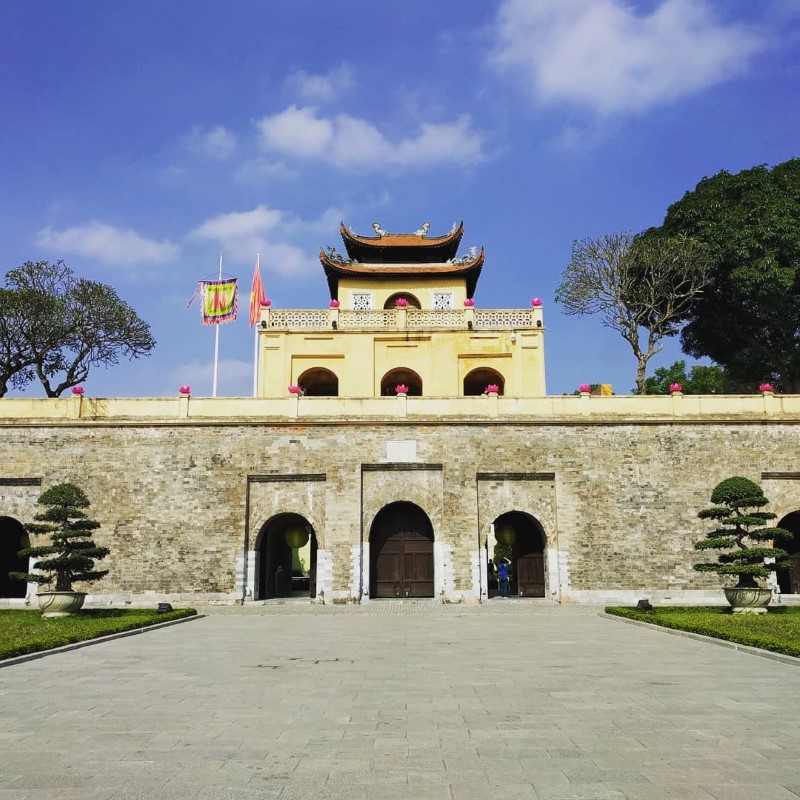
An angle inside the central area
(insta: wzhenq)
The Imperial Citadel in Hanoi is located in 19C Hoang Dieu Street, Ba Dinh District, right in the center of Hanoi. It is surrounded by:
- In the North: Phan Dinh Phung Street
- In the West: Hoang Dieu Street
- In the South: Dien Bien Phu Street
- In the East: Nguyen Tri Phuong Street
This prominent site is only 2.5 kilometers from Hoan Kiem Lake, also within a 15-minute walk from attractions such as Quan Thanh Temple, Vietnam Military History Museum,…
It is very easily accessible from the city center.
History
Imperial Citadel of Thang Long is associated with the history of Hanoi. This construction was built in several dynasties throughout different historical periods.
In the feudal era
In 1010, Dai La ( now is Hanoi) was chosen as the new capital of the country by King Ly Thai To in Ly Dynasty (1009 – 1225). Shortly after moving the capital, Imperial Citadel of Thang Long was built and finished in early 1011.
Artistic rendition of the central area in Ly dynasty
In the Tran (1226-1400) and Early Le dynasty (1428-1527), The Citadel was continued to be used. They repaired and kept on building new architectures.
The Imperial Citadel of Thang Long was severely damaged by wars during the period of Mac (1527-1592) and Le Dynasty (1593-1789).
Then, King Quang Trung (Tay Son Dynasty) (1778 – 1802) moved the capital to Phu Xuan (now is Hue), Thang Long was no longer the capital until the end of Nguyen Dynasty.
In the Nguyen dynasty (1802-1945), King Minh Mang was the one who changed the name of Thang Long into Hanoi, as called in present time.
When the entire Indochina was taken over, the French chose Hanoi as the capital of the French Indochina Federation and the Imperial Citadel of Thang Long was demolished for the French Army.
In 1954, when the Vietnamese Army took over the liberation of Hanoi, The Citadel became the headquarter of the Ministry of Defense.
In the present time, Hanoi Imperial Citadel is one of the most popular tourist attractions in Hanoi.
Cultural Values
The Imperial Citadel of Thang Long is a valuable cultural heritage with more than 10 centuries of history.
Many artifacts and items dating back to between the 6th and 20th centuries were excavated recently at the archaeological site, including foundations of old palaces, ancient roads, ponds, wells, and ceramics. The discovery helped to reveal the richness of Vietnamese culture.
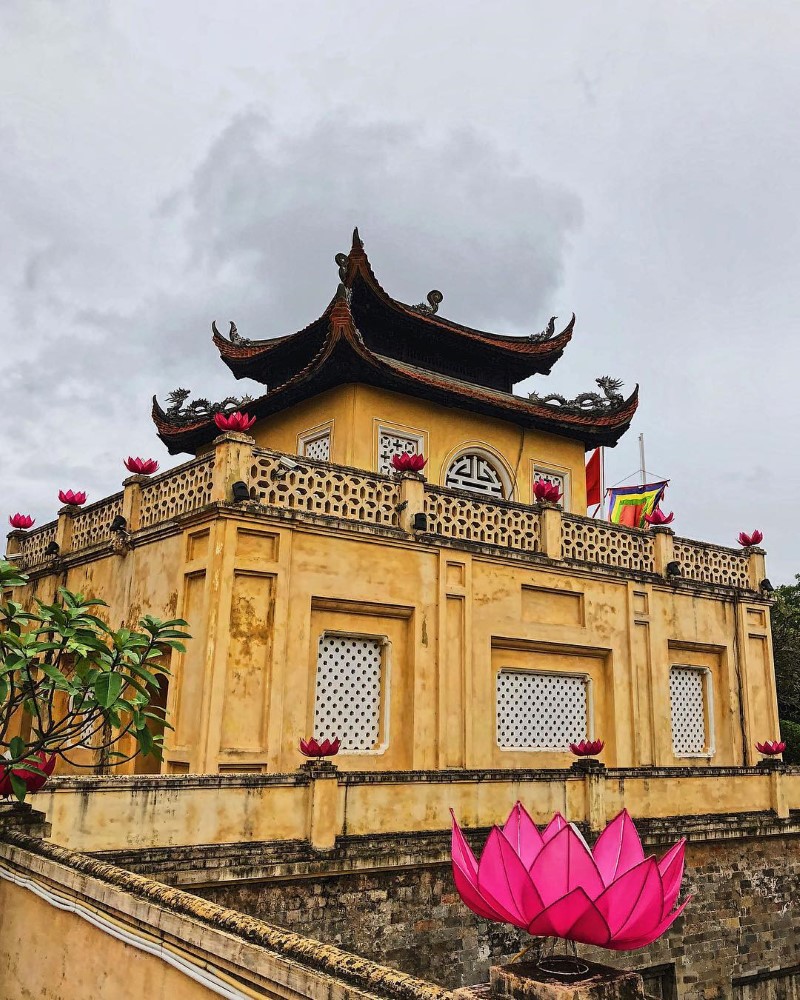
Every corner is like a movie scene
(insta: nathaliedesomer)
Being an intriguing relic of Vietnam’s history and, signifying its historical and cultural importance, The Imperial Citadel of Thang Long was announced as top 10 national treasures of Vietnam in 2009. In 2010, it was officially recognized as a UNESCO World Heritage Site.
Unfortunately, during war periods, many parts of the Citadel were destroyed and unable to recreate. However, remaining architectures have been preserved and since become some of the most popular tourist attractions in Hanoi.
The Architecture of Imperial Citadel of Thang Long in Hanoi
Flag Tower (Ky Dai)
The flag tower of Hanoi (also called Ky Dai) is a monument built in 1812, under the Nguyen Dynasty – the last feudal dynasty of Vietnam.
>>> See Hanoi Flag Tower Opening Hours Entrance Fee of The Hanoi
Consists of 4 levels, each level has a flower wall with surrounding pattern
The base: 42.5 meters long; 3.1 meters high
The second floor: 27 meters long; 3,7 meters high
The third floor: 12.8 meters long; 5.1 meters high
The top: cylindrical pillar with Vietnamese National Flag on top; 2.13 meters long; 18.2 meters high

The proud Flag tower of Hanoi
(insta: deeps_pace)
At the third floor, there are 4 gates with meaningful names located in 4 cardinal directions:
The East gate: “Ngênh Húc” which means to welcome the sunlight
The West gate: “ Hồi Quang” which means to reflect the sunlight
The South gate is named “Hướng Minh” which means to lean toward the sunlight
The North gate doesn’t have a name.
Kinh Thien Palace
Kinh Thien Palace which was built in 1428, is the central relic in the whole of the Imperial Citadel of Thang Long. This was where imperial ceremonies and great national affairs were celebrated.
In front of Kinh Thien Palace
The palace’s foundation is 57 meters long, 41.5 meters wide, 2.3 meters high

The green stone dragon statues are sophisticate carved
(insta: naikitektura)
In front of the palace: 4 dragon statues made of greenstone along the stairs
At the back of the palace: 2 dragon statues made of greenstone along the smaller stairs
Doan Mon (South Gate)
Doan Mon which was built in Le Dynasty is the South gate of the Citadel. This was where only the royal and its relatives could pass through.
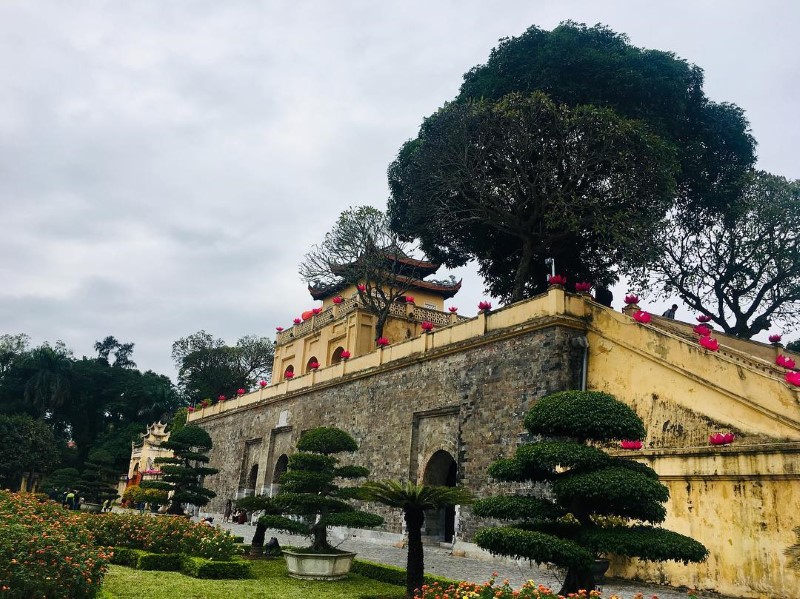
Doan Mon nowadays
(insta: nadhizzle)
Doan Mon has 3 floors overall:
The bottom floor:
Built according to the architecture of the ancient wall
5 gates: 1 main gate and 4 side gates.
The gates were constructed from monolithic logs, running on a large wooden wheeled system made by steel
The second floor:
A sliding door system in all directions.
Where the king stayed to cheer up the spirit of soldiers before the war, welcomed generals back from wars or enjoyed martial arts performances, folk games,…
The top floor:
2 sub-floors with 8 roofs in total.
All the roofs are decorated with dragon pattern.
Bac Mon (North Gate)
If Doan Mon is the South Gate, then Bac Mon is the North Gate of the Citadel. These two gates are the only 2 remaining gates of the Imperial Citadel of Thang Long in Hanoi.

Bac Mon (North Gate)
Built with brick and arches of stone.
71 meters high, 17.08 meters wide, 2.48 meters of thick wall.
Above the Bac Mon Gate is a wooden gazebo built of eight layers of roof tiles and 4 gates in 4 cardinal directions.
Now, this is the place to worship 2 city’s heroes who are Nguyen Tri Phuong and Hoang Dieu. These two heroes were the leaders against the invasion of the French colonialists in Hanoi in 1873 and 1882.
Altar of Nguyen Tri Phuong and Hoang Dieu
Hau Lau (Princess Pagoda)
Hau Lau was built in 1821 and is about 2.392 square meters. This place was the residence of the queens and princesses.

Hau Lau (Princess Pagoda)
(insta: jennypea)
Built of brick
1 basement and 3 floors above the basement.
Tiled roof with brick and concrete structure
The French called Hau Lau “Pagode des Dames”. At the end of the 19th century, Hau Lau was severely damaged, after which the French rebuilt the monument as today.
D67 House and tunnel
Previously, this place was the headquarter of the Vietnamese People’s Army during the Vietnam war from 1954 to 1975.
D67 House was built in 1967 with modern architecture:
Wall thickness of 0,6 meters
A sound insulation system for security.
Made of solid and bulk concrete and steel.
Inside D67 House
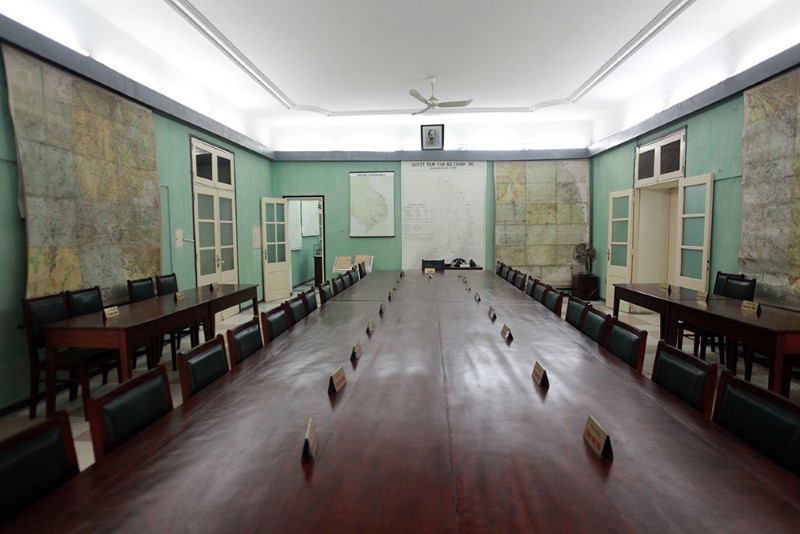
The meeting room
1 meeting room of the Central Military Committee ( about 76 square meters wide),
1 break room ( about 37 square meters wide).
1 small room in the East: the workplace of General Vo Nguyen Giap,
1 small room in the West: the workplace of General Van Tien Dung.
2 stairs connecting to D67 Tunnel
Here exhibit some objects of the comrades in the Military that had been used during the Vietnam war.
Objects and items used during the Vietnam War
Inside D67 Tunnel
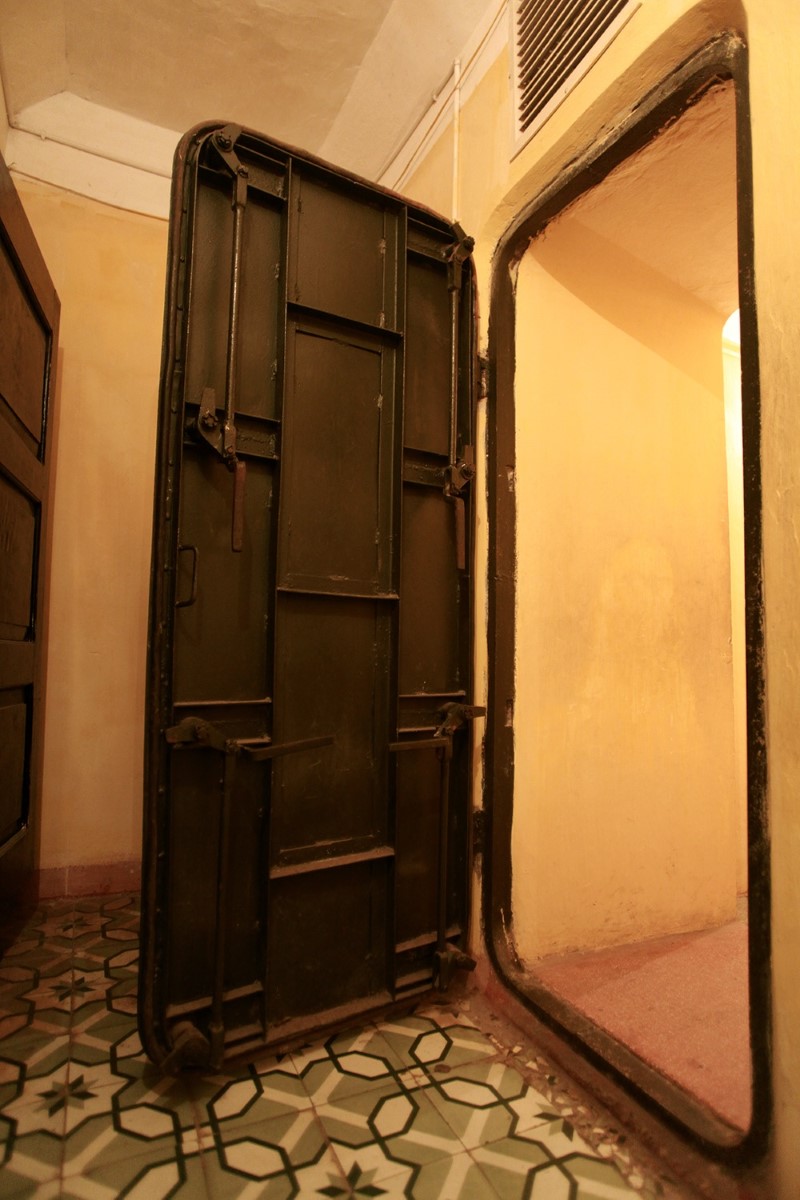
The huge iron soundproof door for secret meetings
Lay below the D67 House
9 meters deep
Built of solid concrete to prevent bombs.
3 stairs: 1 southern staircase connects to the Dragon House, 2 northern stairs connects to the D67 House.
3 rooms, the largest room is the hall of residence.
There are also a lot of artifacts left such as the desk of the General Staff, the large map to navigate enemy’s aircraft, telegraph connected to the Presidential Palace, the enemy’s aircraft notice board,…

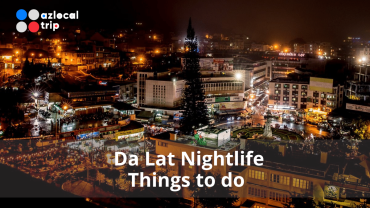







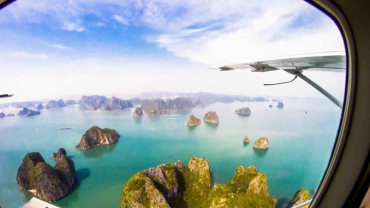

Comment (0)